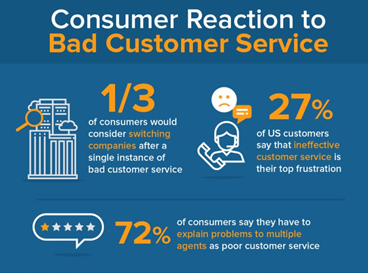In today’s business world, the expectation of on-demand customer service is higher than ever, with very little tolerance for sub-par service. Companies need to meet or exceed customer expectations, or risk failure in a competitive market.
It doesn’t take a rocket scientist to understand that a poor experience with your brand is terrible for business – but just how bad can it be? Surveys have indicated that a whopping 63% of U.S. customers have switched brands due to poor customer service, and a third would consider switching after just one bad interaction.

Source: Finances online
On the flip side, 86% of customers are willing to spend more to have a great experience, and 93% are more likely to make a repeat purchase with businesses that they have a great experience with.
Barriers to delivering a great experience
Today’s organizations use a broad range of complex technologies to service the customers – from websites, live chat, and online portals to contact centers, Interactive Voice Response (IVR), contact centers, and more. These channels all need to work in tandem to deliver a seamless omnichannel customer journey.
While these journeys may be well designed, and driven by state-of-the-art technologies, the Customer Experience (CX) needs to be thoroughly tested to ensure the journeys eventuate the way you envisioned them. So how do you know if your technology will perform the way you intend?
Testing 1, 2, 3
Customer service-focused organizations need a way to test the whole chain of the customer journey. Testing solutions should apply to digital, voice and video channels, call routing, Computer Telephony Integration (CTI) and agent equipment and applications.
Broadly speaking, testing falls into two categories:
- Functional testing
- Performance testing
Functional testing
Functional testing needs to be done across the complete technology stack to deliver a successful omnichannel journey to check if defects have affected software after a change has been made. Types of metrics in this category include:
- System integration testing. This is to see if a system works properly in a live situation after software integration.
- Component testing. Also known as program or module testing, this is where elements can be tested independently as a component without integrating with other components.
- Usability testing. This gauges the satisfaction level of customers after interacting with the system parameters.
- User acceptance testing. The process of testing the system performance according to pre-validated criteria.
Performance testing
Performance testing identifies correct speed, response time and system scalability. Here are some metrics and examples of use cases:
- Load testing. Finding potential weak and critical spots, as well as potential for maximum system loads under unexpected conditions.
Load testing use case:
Customer – Retail/Entertainment
Goal – Make sure their online site and customer care centers are ready for the holiday season.
Solution – StressTest for both voice and web with testing focused on reaching maximum levels using a controlled ramp-up plan.
Outcome – This allowed the customer to verify at what point their systems began slowing down and because this was not at the max level, additional resources were added, and the system was tested again until reaching their max capacity with acceptable response times.
- General performance testing. Defining software response time under specific conditions and accessing data and analytics about availability and performance.
Performance testing use case:
Customer – Large Financial Institution
Goal – Tracking availability on premise-based solution.
Solution – HeartBeat test cases were configured with specific SLAs in mind to provide 3rd party documentation about availability and performance.
Outcome – Customer based employee KPIs on the NOC team around the data received by HeartBeat. The service availability numbers were across the whole system rather than a specific vendor or carrier solution.
Customer service is the lifeblood of a business. Comprehensive testing of customer focused systems is essential to maintain a great CX all the time.
Want to find out more about how we can help you deliver the experience your customers expect? Click here to explore our testing solutions.




